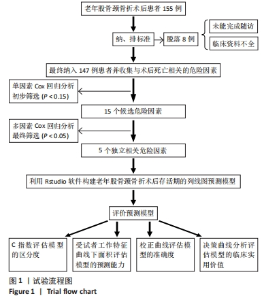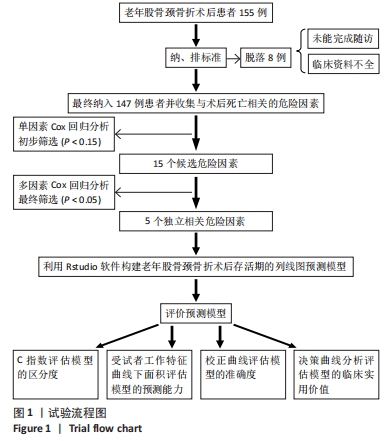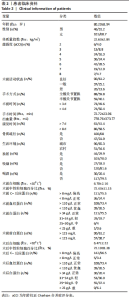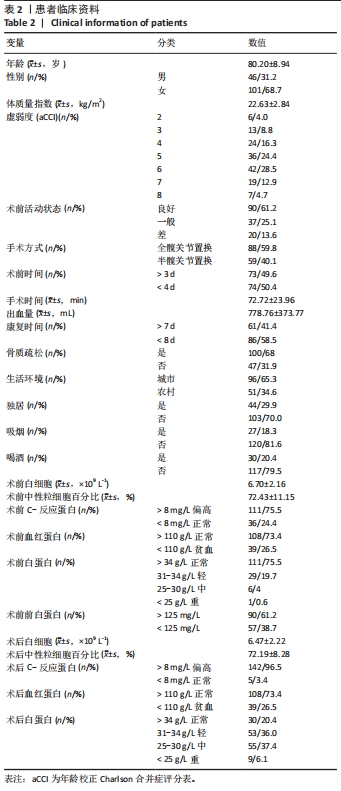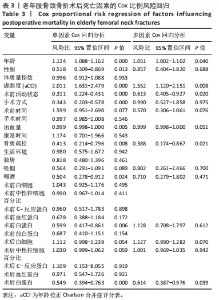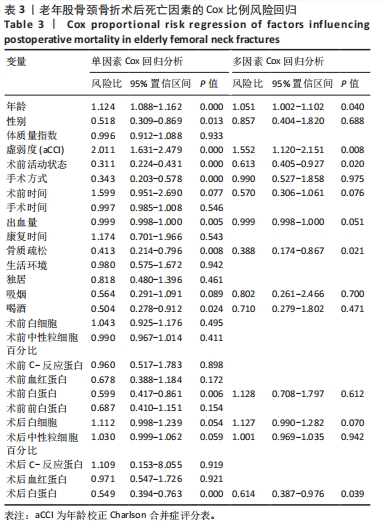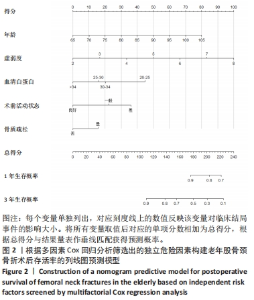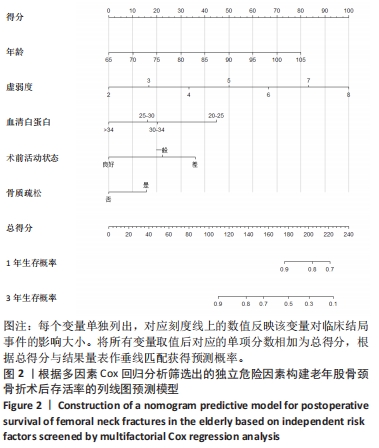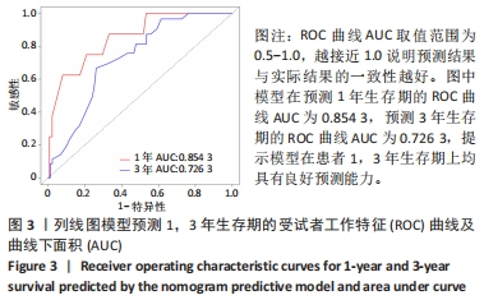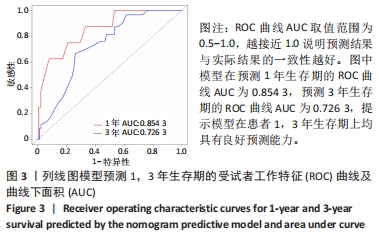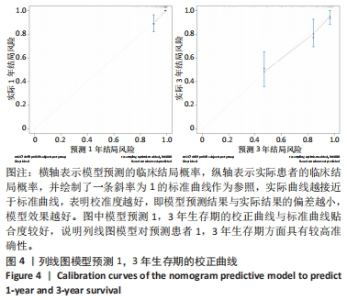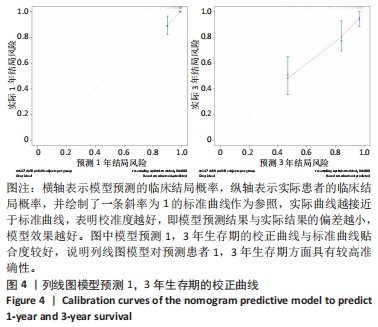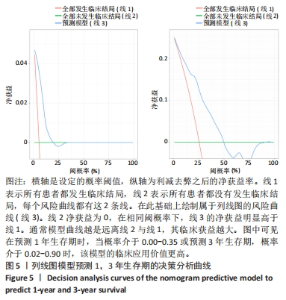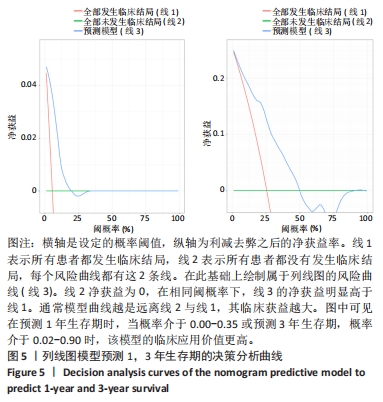Chinese Journal of Tissue Engineering Research ›› 2024, Vol. 28 ›› Issue (21): 3361-3366.doi: 10.12307/2024.095
Previous Articles Next Articles
Risk factors of postoperative mortality of femoral neck fractures in elderly patients and construction of a nomogram predictive model
Li Zhipeng, Huan Dawei, Yuan Zhaofeng, Qiu Yue, Zhang Chao, Xia Tianwei, Shen Jirong
- Affiliated Hospital of Nanjing University of Chinese Medicine (Jiangsu Province Hospital of Chinese Medicine), Nanjing 210004, Jiangsu Province, China
-
Received:2023-05-21Accepted:2023-06-28Online:2024-07-28Published:2023-09-27 -
Contact:Shen Jirong, Chief physician, Master’s supervisor, Affiliated Hospital of Nanjing University of Chinese Medicine (Jiangsu Province Hospital of Chinese Medicine), Nanjing 210004, Jiangsu Province, China -
About author:Li Zhipeng, Master candidate, Affiliated Hospital of Nanjing University of Chinese Medicine (Jiangsu Province Hospital of Chinese Medicine), Nanjing 210004, Jiangsu Province, China
CLC Number:
Cite this article
Li Zhipeng, Huan Dawei, Yuan Zhaofeng, Qiu Yue, Zhang Chao, Xia Tianwei, Shen Jirong. Risk factors of postoperative mortality of femoral neck fractures in elderly patients and construction of a nomogram predictive model[J]. Chinese Journal of Tissue Engineering Research, 2024, 28(21): 3361-3366.
share this article
Add to citation manager EndNote|Reference Manager|ProCite|BibTeX|RefWorks
| [1] DOWNEY C, KELLY M, QUINLAN JF. Changing trends in the mortality rate at 1-year post hip fracture - a systematic review. World J Orthop. 2019;10(3):166-175. [2] PAN L, NING T, WU H, et al. Prognostic nomogram for risk of mortality after hip fracture surgery in geriatrics. Injury. 2022;53(4):1484-1489. [3] BHANDARI M, SWIONTKOWSKI M. Management of Acute Hip Fracture. N Engl J Med. 2017;377(21):2053-2062. [4] XIA ZN, XIAO K, ZHU W, et al. Risk assessment and management of preoperative venous thromboembolism following femoral neck fracture. J Orthop Surg Res. 2018;13(1): 291. [5] ZHANG XM, WU XJ, CAO J, et al. Effect of the Age-Adjusted Charlson Comorbidity Index on All-Cause Mortality and Readmission in Older Surgical Patients: A National Multicenter, Prospective Cohort Study. Front Med (Lausanne). 2022;9:896451. [6] ZHANG DL, CONG YX, ZHUANG Y, et al. Age-adjusted Charlson comorbidity index predicts postoperative mortality in elderly patients with hip fracture: A prospective cohort. Front Med (Lausanne). 2023;10:1066145. [7] LUTNICK E, KANG J, FRECCERO DM. Surgical Treatment of Femoral Neck Fractures: A Brief Review. Geriatrics (Basel). 2020;5(2):22. [8] BI ZG, WANG XM. [Reviewing the surgery strategy for fracture neck of femur]. Zhonghua Wai Ke Za Zhi. 2019;57(11):804-806. [9] MORRI M, AMBROSI E, CHIARI P, et al. One-year mortality after hip fracture surgery and prognostic factors: a prospective cohort study. Sci Rep. 2019;9(1):18718. [10] HUETTE P, ABOU-ARAB O, DJEBARA AE, et al. Risk factors and mortality of patients undergoing hip fracture surgery: a one-year follow-up study. Sci Rep. 2020;10(1): 9607. [11] BZOVSKY S, COMEAU-GAUTHIER M, SCHEMITSCH EH, et al. Factors Associated With Mortality After Surgical Management of Femoral Neck Fractures. J Orthop Trauma. 2020;34 Suppl 3:S15-S21. [12] 鲁攀攀, 谢添, 代广春, 等. 老年股骨颈骨折患者人工股骨头置换术后死亡的危险因素分析[J]. 中国修复重建外科杂志,2021,35(2):217-220. [13] PAN L, NING T, WU H, et al. Prognostic nomogram for risk of mortality after hip fracture surgery in geriatrics. Injury. 2022;53(4):1484-1489. [14] XING F, LUO R, CHEN W, et al. The risk-adjusted Charlson comorbidity index as a new predictor of one-year mortality rate in elderly Chinese patients who underwent hip fracture surgery. Orthop Traumatol Surg Res. 2021;107(3):102860. [15] VARADY NH, GILLINOV SM, YEUNG CM, et al. The Charlson and Elixhauser Scores Outperform the American Society of Anesthesiologists Score in Assessing 1-year Mortality Risk After Hip Fracture Surgery. Clin Orthop Relat Res. 2021;479(9): 1970-1979. [16] SATHIYAKUMAR V, AVILUCEA FR, WHITING PS, et al. Risk factors for adverse cardiac events in hip fracture patients: an analysis of NSQIP data. Int Orthop. 2016;40(3):439-445. [17] HO-LE TP, TRAN TS, BLIUC D, et al. Epidemiological transition to mortality and refracture following an initial fracture. Elife. 2021;10:e61142. [18] LI XP, ZHANG P, ZHU SW, et al. All-cause mortality risk in older patients with femoral neck fracture. BMC Musculoskelet Disord. 2022;23(1):941. [19] ZANKER J, DUQUE G. Rapid Geriatric Assessment of Hip Fracture. Clin Geriatr Med. 2017;33(3):369-382. [20] FU G, LI M, XUE Y, et al. Rapid preoperative predicting tools for 1-year mortality and walking ability of Asian elderly femoral neck fracture patients who planned for hip arthroplasty. J Orthop Surg Res. 2021;16(1):455. [21] ZANKER J, DUQUE G. Rapid Geriatric Assessment of Hip Fracture. Clin Geriatr Med. 2017;33(3):369-382. [22] GOPINATH V. Osteoporosis. Med Clin North Am. 2023;107(2):213-225. [23] 马远征, 王以朋, 刘强, 等. 中国老年骨质疏松诊疗指南(2018)[J]. 中国老年学杂志,2019,39(11):2557-2575. [24] SI L, WINZENBERG TM, JIANG Q, et al. Projection of osteoporosis-related fractures and costs in China: 2010-2050. Osteoporos Int. 2015;26(7):1929-1937. [25] LIU B, LIU SK, WU T, et al. Risk Factors for Intraoperative Periprosthetic Femoral Fractures in Patients with Hip Dysplasia Undergoing Total Hip Arthroplasty with Uncemented Prostheses. Orthop Surg. 2021;13(6):1870-1881. [26] COHEN JS, AGARWAL AR, KINNARD MJ, et al. The Association of Postoperative Osteoporosis Therapy With Periprosthetic Fracture Risk in Patients Undergoing Arthroplasty for Femoral Neck Fractures. J Arthroplasty. 2023;38(4):726-731. [27] JANK R, GALLEE A, BOECKLE M, et al. Chronic Pain and Sleep Disorders in Primary Care. Pain Res Treat. 2017;2017:9081802. [28] 中华医学会骨质疏松和骨矿盐疾病分会, 章振林. 原发性骨质疏松症诊疗指南(2022)[J]. 中国全科医学,2023,26(14):1671-1691. [29] TAI TW, LI CC, HUANG CF, et al. Treatment of osteoporosis after hip fracture is associated with lower all-cause mortality: A nationwide population study. Bone. 2022;154:116216. [30] FISHER A, FISHER L, SRIKUSALANUKUL W, et al. Usefulness of simple biomarkers at admission as independent indicators and predictors of in-hospital mortality in older hip fracture patients. Injury. 2018;49(4):829-840. [31] LI S, ZHANG J, ZHENG H, et al. Prognostic Role of Serum Albumin, Total Lymphocyte Count, and Mini Nutritional Assessment on Outcomes After Geriatric Hip Fracture Surgery: A Meta-Analysis and Systematic Review. J Arthroplasty. 2019;34(6):1287-1296. [32] O’LEARY L, JAYATILAKA L, LEADER R, et al. Poor nutritional status correlates with mortality and worse postoperative outcomes in patients with femoral neck fractures. Bone Joint J. 2021;103-B(1):164-169. [33] SIM SD, SIM YE, TAY K, et al. Preoperative hypoalbuminemia: Poor functional outcomes and quality of life after hip fracture surgery. Bone. 2021;143:115567. [34] LIZAUR-UTRILLA A, GONZALEZ-NAVARRO B, VIZCAYA-MORENO MF, et al. Altered seric levels of albumin, sodium and parathyroid hormone may predict early mortality following hip fracture surgery in elderly. Int Orthop. 2019;43(12):2825-2829. [35] WANG X, LU J, SONG Z, et al. From past to future: Bibliometric analysis of global research productivity on nomogram (2000-2021). Front Public Health. 2022;10: 997713. |
| [1] | Xi Jintao, Lu Qilin, Wang Yang, Wang Xiaojuan, Lyu Peng, Chen Long, Shi Zhen, Xie Wei, Zhu Yiliang, Li Xugui. Risk factors for cage retropulsion following transforaminal lumbar interbody fusion [J]. Chinese Journal of Tissue Engineering Research, 2024, 28(9): 1394-1398. |
| [2] | Yang Cekai, Cai Zhuoyan, Chen Ming, Liu Hao, Weng Rui, Cui Jianchao, Zhang Shuncong, Yao Zhensong. Relationship between degeneration of paraspinal muscle and refractures in postmenopausal women treated by percutaneous vertebroplasty [J]. Chinese Journal of Tissue Engineering Research, 2024, 28(9): 1414-1419. |
| [3] | Han Bing, Liu Hongbin, Wang Hehong, Zhao Hanqing, Zhao Riguang, Sun Yiyan, Zhang Yu. Correlation between lower limb alignment and risk factors of patellofemoral pain syndrome in young men [J]. Chinese Journal of Tissue Engineering Research, 2024, 28(8): 1211-1216. |
| [4] | Xue Xiaofeng, Wei Yongkang, Qiao Xiaohong, Du Yuyong, Niu Jianjun, Ren Lixin, Yang Huifeng, Zhang Zhimin, Guo Yuan, Chen Weiyi. Finite element analysis of osteoporosis in proximal femur after cannulated screw fixation for femoral neck fracture [J]. Chinese Journal of Tissue Engineering Research, 2024, 28(6): 862-867. |
| [5] | Tan Nengxian, Wu Wenzheng, Zheng Churong, Luo Lieliang, Gu Peng, Ouyang Chongzhi, Zheng Xiaohui. Finite element analysis of different fixation methods of partially threaded cannulated screws for treating vertical femoral neck fractures [J]. Chinese Journal of Tissue Engineering Research, 2024, 28(6): 873-878. |
| [6] | Hou Zexin, Xu Benke, Dai Yuan, He Chuan, Zhang Chaoju, Li Xiaolin. Finite element analysis of the mechanism of dorsiflexion injury of wrist joint in elderly people after falls [J]. Chinese Journal of Tissue Engineering Research, 2024, 28(6): 886-890. |
| [7] | Xu Daxing, Ji Muqiang, Tu Zesong, Xu Weipeng, Xu Weilong, Niu Wei. Constructing a risk prediction model for failure after locking plate fixation for proximal humeral fractures in the elderly by combining the deltoid tuberosity index with preoperative factors [J]. Chinese Journal of Tissue Engineering Research, 2024, 28(21): 3299-3305. |
| [8] | Jia Jizhai, Yin Guikun, Xie Hui, Fu Weimin, Han Shun, Ma Yingjie, Wen Zhun, Wang Benjie. Finite element analysis of femoral neck fracture treated by internal fixation of femoral neck system under nonanatomical reduction [J]. Chinese Journal of Tissue Engineering Research, 2024, 28(21): 3319-3325. |
| [9] | Zhu Shijie, Yang Yiting, Cao Yuting, Zheng Liangdong, Lin Kaili, Zhu Rui. Cartilage protective effect of swimming exercise in aged mice with knee osteoarthritis [J]. Chinese Journal of Tissue Engineering Research, 2024, 28(20): 3170-3175. |
| [10] | Wang Dening, Zhang Kefan, Shi Hui, Du Changling, Wang Xin. Imaging analysis of anatomical morphological risk factors for posterior cruciate ligament injury of the knee [J]. Chinese Journal of Tissue Engineering Research, 2024, 28(18): 2887-2894. |
| [11] | Jiang Yu, Luo Yan, Lin Xisheng, Wang Yilin, Gao Zefu, Lyu Houchen, Zhang Licheng, Tang Peifu, Liu Yujie. Effect of dementia on postoperative complications in older patients with hip fractures [J]. Chinese Journal of Tissue Engineering Research, 2024, 28(18): 2895-2900. |
| [12] | Li Peng, Han Xiaosong, Xiang Bingyan, He Yingyi, Huang Kun, Liu Li, Luo Hongjian, Ruan Shiqiang. Application and economic effects of digital three-dimensional reconstruction in hip hemiarthroplasty for intertrochanteric femoral fractures in the elderly [J]. Chinese Journal of Tissue Engineering Research, 2024, 28(18): 2814-2818. |
| [13] | Chang Feng, Li Yanlong. Fracture risk analysis and prediction of low bone mass tangential points in middle-aged and elderly women with different chronic diseases [J]. Chinese Journal of Tissue Engineering Research, 2024, 28(14): 2140-2144. |
| [14] | Wang Ji, Hu Li, Yang Zhongya, Han Peng. A cross-sectional survey on the prevalence and risk factors of sarcopenia in the elderly in some areas of the Yunnan-Guizhou Plateau [J]. Chinese Journal of Tissue Engineering Research, 2024, 28(14): 2197-2201. |
| [15] | Gao Siyu, Yao Lihong, Bian Zhilei, Zhang Suping, Li Li, Fan Jinpeng, Qin Jing, Peng Yingnan, Wan Dingming. Analysis of risk factors for short-term death after allogeneic hematopoietic stem cell transplantation [J]. Chinese Journal of Tissue Engineering Research, 2024, 28(13): 2009-2016. |
| Viewed | ||||||
|
Full text |
|
|||||
|
Abstract |
|
|||||
